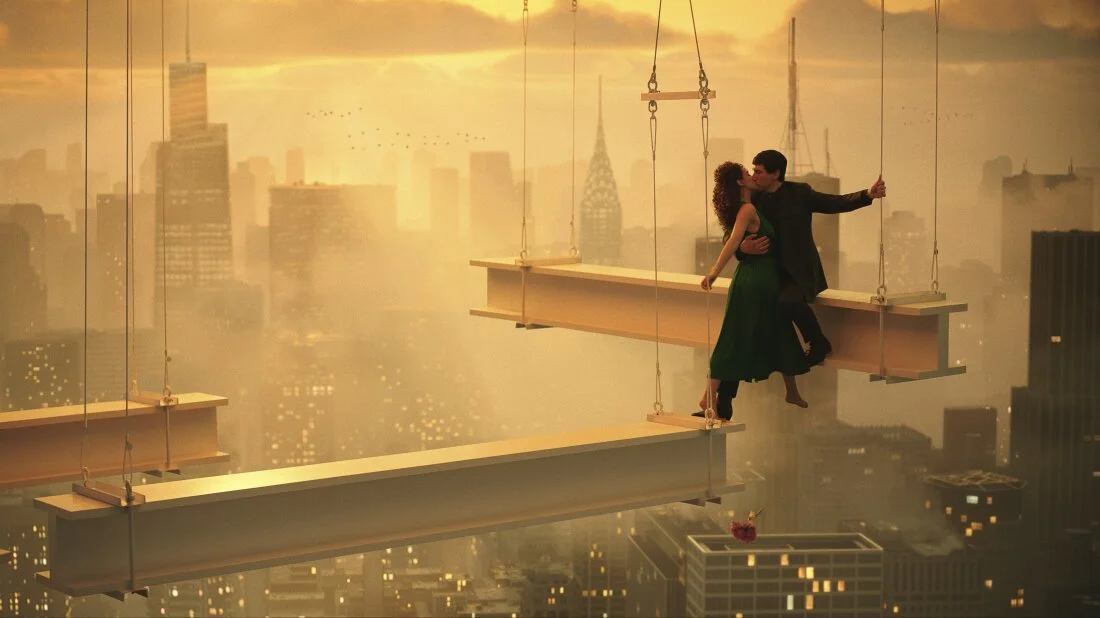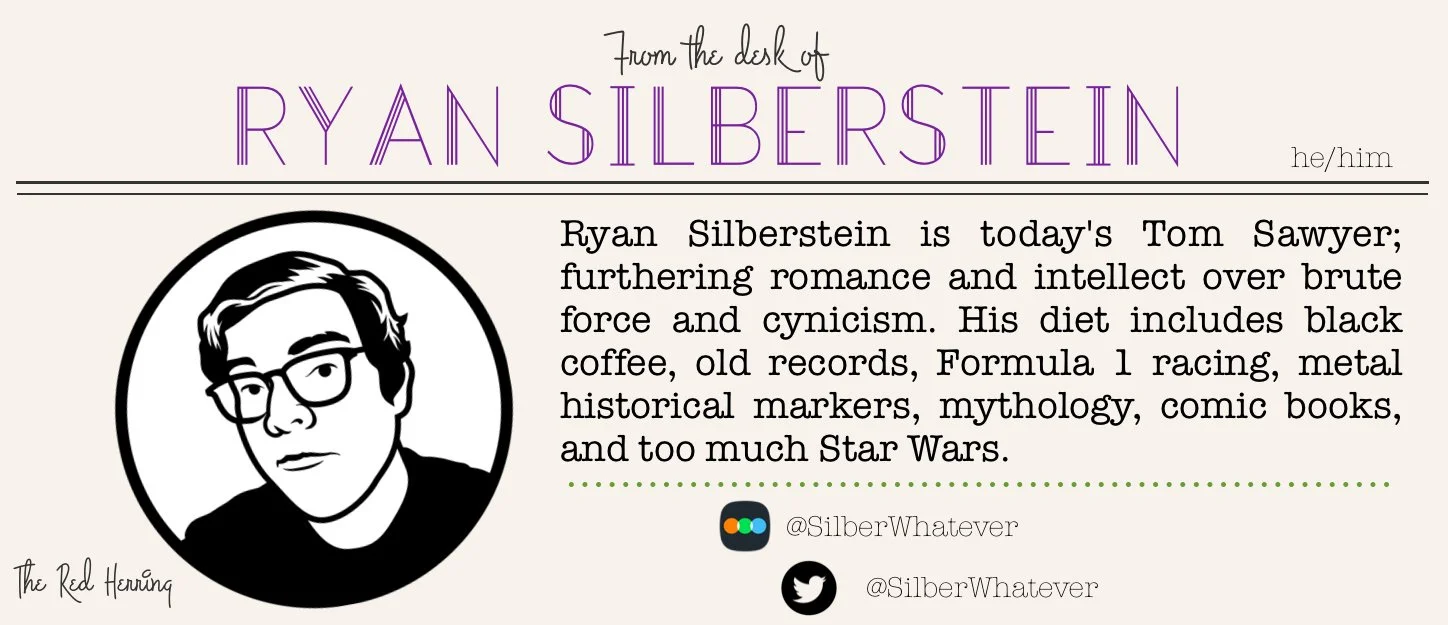Ambitious, idiosyncratic, and moving: MEGALOPOLIS is my new Roman Empire
Megalopolis
Written and Directed by Francis Ford Coppola
Starring Adam Driver, Nathalie Emmanuel, Aubrey Plaza
Rated R
Runtime: 138 minutes
In theaters September 27
by Ryan Silberstein, Managing Editor, Red Herring
Money makes time. It used to be the other way around. Clock time accelerated the rise of capitalism. People stopped thinking about eternity. They began to concentrate on hours, measurable hours, man-hours, using labor more efficiently.
― Don DeLillo, Cosmopolis (2003)
When does an empire die? In Megalopolis, writer-director Francis Ford Coppola posits that it occurs when its people stop believing in it. For America–which Emerson described as “the country of the future…of projects, vast designs and expectations”–we have largely stopped talking about the future. Two centuries ago, we were preoccupied with the questions of expansions and slavery. A century ago, we were racing toward a Great Depression while reveling in decadence. But now, we are sold happiness as cheap consumer goods, and those in power seem dedicated to preserving the status quo above all. This is not to dismiss the societal and technological progress that has been made, but the idea of progress itself has become more and more politicized. In his first film in 13 years, Coppola has literalized the idea of a stagnating American Empire by depicting a version of New York literally called New Rome, complete with Roman names and Cesar haircuts on most of the men in the film. Taking influence from the Catilinarian conspiracy in 63 BC, Coppola allegorically explores the late-stage American Republic through an alternate near-future where the future of New Rome is the central theme.
Architect Cesar Catilina (Adam Driver), nephew to the powerful banker Hamilton Crassus III (Jon Voight), is a dreamer. To achieve his dreams, he has unlocked the power of Megalon, a new material that can make the impossible possible, including a utopian city of the future, Megalopolis, that will be sustainable and human-first. Opposing him is the corrupt Mayor Franklyn Cicero (Giancarlo Esposito), who wishes to maintain the city’s status quo of failing infrastructure. In parallel, the Mayor’s daughter, Julia (Nathalie Emmanuel) finds herself drawn to Cesar and his ideas for a better tomorrow. This love affair reignites not only the lifelong jealousy of Cesar’s cousin, Clodio (Shia LaBeouf) but also attracts the scorn of the architect’s ambitious ex-lover Wow Platinum (Aubrey Plaza).
Watching Megalopolis is equal parts dazzling and enthralling. Every aspect of the film is subservient to the ideas Coppola is exploring, and narrative and character are sometimes ignored in favor of soliloquy and emotion. In a time where so many of the most vocal movie fans laud films for their groundedness, realism, and naturalism, Coppola is pushing back with something theatrical and lofty. Pointing out “plot holes” (a largely mythical concept) or asking why something “doesn’t make sense” are methods used to create distance between the viewer and the work. By those standards, Megalopolis will be disappointing; likewise, the only irony at play here is dramatic.
An early scene has Cesar arriving to make his proposal for Megalopolis and introducing himself by reciting the “to be or not to be” speech from Act 3 of Hamlet. But Coppola’s approach to Megalopolis is more indebted to Henrik Ibsen and James Joyce than to Shakespeare. Here, Coppola pushes through melodrama and realism into an ecstatic truth, showcasing the swirling back and forth between emotions and thoughts that pass through our minds. The characters here need as much or as little reason to undertake their actions as we do. Sometimes we understand our motives plainly. Often we do not, and, just as often, our motivations are little more than a means of self-justification. The result is something like Cecil B. de Mille’s The Ten Commandments (1956), David Lynch’s Dune (1984) or Coppola’s own Apocalypse Now (1979), an abstraction that engages on an emotional level as much as an intellectual one. Digesting the film requires an earnest approach and a willingness to think. Like George Bernard Shaw, Coppola teases out ideas in the forms of characters and asks the audience to evaluate them. Megalopolis is more Pygmalian than My Fair Lady (1964).
While Roman history is one of the major influences on Megalopolis, shaping much of its story and aesthetics, is is augmented by a host of other influences. The Metropolis (1927) influence is clear from the title and the Art Deco influence on some aspects of the production design–especially on Cesar’s office, located in the upper floors of the Chrysler Building. Coppola also draws from the history of New York City to build out the film’s world. The Fiscal Crisis of 1975–where the city was on the verge of insolvency due to depleted tax revenue from white flight and stagflation–informs the depiction of Mayor Cicero’s time in office, where services like sanitation and education are collapsing. Additionally, the Design Authority and the latitude given to Cesar in planning his projects draws inspiration from The Power Broker himself, Robert Moses. While Cesar is generally depicted in a positive light, there is also a critique of letting a mad scientist (or mad builder in this case) run amok. He is not far off from Victor Frankenstein or Jack Griffin either. This blending of midcentury and science fiction inspirations points not only to the extended gestation period of this project but also to one of the film’s central themes.
Among Cesar’s gifts–whether derived from Megalon or vice-versa–is the ability to stop time. Whether a painter, a photographer, a writer, or an architect, all artists stop time in some way. They capture frozen moments, and their chosen medium allows us to process them at our leisure. We can walk right by or stop and ponder, soaking in all of the details. The movie director, by contrast, controls time for us. They choose how long a shot will last, how quickly the camera moves, how long it takes an actor to cross the frame. To watch a film, we cede this control back to the artist. But this is not the only reason time is on Cesar’s mind. Or Coppola’s. Megalopolis feels urgent, not only because the present seems to worsen, but because its architect feels like they are running out of time.
This architect is positioned as irresistibly drawn to the future despite living in a world influenced by ancient Rome and working atop the world’s first supertall skyscraper. At the same time, he is still very much in love with his deceased wife while also falling in love with Julia Cicero. In one moving, dreamlike sequence, Cesar is driven through a decaying part of the city where statues are dying among the trash, rubble, ruin, and downtrodden people who live there until he arrives at a glowing flower shop full of life and hope. It is these flowers Cesar brings with him to a sort of dream mausoleum where his wife lays in bed like Sleeping Beauty. We are all haunted by past love. It is part of us whether we like it or not. In contrast, the new love between Cesar and Julia forms as they stand atop clocks and steel beams. They are among the clouds, seeing the whole city laid out below. Together, they soar and can still access the future.
Again, this is contrasted by Mayor Cicero’s view. When Julia arrives at his office, she finds his desk half buried in sand. Cicero is mired in the present and has no outlook on the future. There is only the now. Time, for Cicero, is that of man-hours, wages, and preserving the capitalist status quo. Radical change is a threat because the future cannot be accounted for as predictably, and those who hold power could lose that status if there is too much change. This is why we have two political parties that are barely distinguishable underneath their respective veneers, and why we tolerate horrific acts like institutional poverty, school shootings, and genocide. Because we are comfortable with the status quo.
As Cesar and Julia become more and more entangled, the architect likens her to his muse. It is their love that fuels his ability to create, to dream up the future in a way that is positive for humanity. The way Cesar talks about Megalopolis evokes the language Walt Disney used to describe his vision of E.P.C.O.T.. It was never meant to be a theme park but rather “an experimental prototype community that will always be in a state of becoming. It will never cease to be a living blueprint of the future, where people actually live a life they can’t find anywhere else in the world. Everything in E.P.C.O.T will be dedicated to the happiness of the people who will live, work, and play here.” Coppola’s own connection to E.P.C.O.T. aside, Megalopolis is asking why we stopped talking about the future. Why we abandoned utopia and advancement as a goal.
The other threat in New Rome is Clodio’s attempt at a “Make New Rome Great Again” populist uprising. This threatens both Cesar’s dream of the future as well as Cicero’s preservation of the status quo and shows how populist anger is co-opted by the wealthy as a cudgel to gain more power. Megalopolis offers a history of New York in microcosm as Robert Moses, Ed Koch, and Donald Trump battle for the right to build the future. When we must waste our energies defending the status quo from fascism, we lose sight of the future, dismantling societal progress with hatchets to build barricades against the barbarism of jackboots. We are constantly reminded not to make perfection the enemy of the good, but when “evil” and “lesser evil” are presented as our best two options, it is easy to forget that something better also actually exists.
Coppola weaves such large tapestry it would be easy to get lost among the threads. But there is much here that asks to be engaged with and, for those of us who feel the future is even further out of reach, calls to keep looking ahead. Better days can come, but only if we create them. Megalopolis deserves to be considered in conversation with The Godfather and Apocalypse Now not just as explorations of the American Empire, but as proof to the power of cinema to convey the nuance and complexity that shapes the human experience itself.




